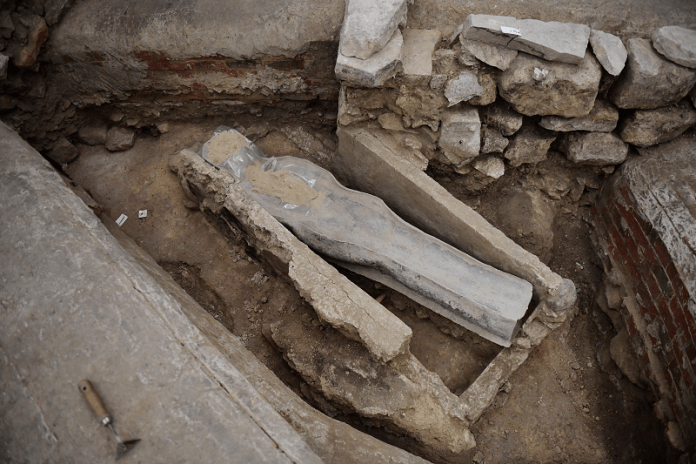The story of two coffins that French archaeologists found under the rubble of Notre Dame Cathedral in Paris last April came back to the fore after it was destroyed by a fire in 2019. Scientists discovered that the person buried in one of the two coffins under the floor of Notre Dame Cathedral is one of the rich persons and philanthropists.
The British newspaper “The Guardian” stated that the name of one of the buried is engraved on a copper plate fixed to a lead coffin, and it belongs to the priest Antoine de la Porte, who was 83 years old and died in 1710, reports a local Arabic daily quoting AFP.
De la Porte was very rich and influential, and at that time he asked to paint several paintings that are currently displayed in the Louvre Museum, including the painting “Mass of the Priest Antoine de la Porte” by Jean Jouvenier. He also allocated 10,000 livres to repair the choir of Notre Dame Cathedral.
Scientists are trying to determine the identity of the person buried in the other coffin, which was found in the cathedral.
“If he died in the second half of the 16th century or early 17th century, we will identify him from the record,” says lead researcher Christophe Bennett. But we may never know who he was, if he had died before.’
However, the researchers determined that buried in the coffin was a man who was 30 years old when he died, as he belonged to the elite, and this is indicated by the location of his grave, and he was suffering from a chronic disease, which led to the loss of his teeth, and his skull was deformed, perhaps due to wearing a headdress or a headband when He was a baby. Researchers believe, based on his pelvic bones, that he was an accomplished horseman.
The researchers noted that the condition of the remains of this person is bad due to the entry of air into the coffin, although it was mummified, although embalming in the Middle Ages was rare, and he was buried with flowers.
Scientists found the two sarcophagi during excavations that took place after the 2019 fire, as well as a number of carvings identified as parts of the original 13th-century partition, the architectural element that separates the altar from the nave.
According to Agence France-Presse, most of the artifacts were found under the floor of the cathedral at a depth of only 20 cm. As for the coffin, which repeats the shape of the body, it was at a depth of one meter. Notre Dame Cathedral and the secret of ‘mysterious sarcophagus’
The story of two coffins that French archaeologists found under the rubble of Notre Dame Cathedral in Paris last April came back to the fore after it was destroyed by a fire in 2019. Scientists discovered that the person buried in one of the two coffins under the floor of Notre Dame Cathedral is one of the rich persons and philanthropists.
The British newspaper “The Guardian” stated that the name of one of the buried is engraved on a copper plate fixed to a lead coffin, and it belongs to the priest Antoine de la Porte, who was 83 years old and died in 1710, reports a local Arabic daily quoting AFP.
De la Porte was very rich and influential, and at that time he asked to paint several paintings that are currently displayed in the Louvre Museum, including the painting “Mass of the Priest Antoine de la Porte” by Jean Jouvenier. He also allocated 10,000 livres to repair the choir of Notre Dame Cathedral.
Scientists are trying to determine the identity of the person buried in the other coffin, which was found in the cathedral.
“If he died in the second half of the 16th century or early 17th century, we will identify him from the record,” says lead researcher Christophe Bennett. But we may never know who he was, if he had died before.’
However, the researchers determined that buried in the coffin was a man who was 30 years old when he died, as he belonged to the elite, and this is indicated by the location of his grave, and he was suffering from a chronic disease, which led to the loss of his teeth, and his skull was deformed, perhaps due to wearing a headdress or a headband when He was a baby. Researchers believe, based on his pelvic bones, that he was an accomplished horseman.
The researchers noted that the condition of the remains of this person is bad due to the entry of air into the coffin, although it was mummified, although embalming in the Middle Ages was rare, and he was buried with flowers.
Scientists founded two sarcophagi during excavations that took place after the 2019 fire, as well as a number of carvings identified as parts of the original 13th-century partition, the architectural element that separates the altar from the nave.
According to Agence France-Presse, most of the artifacts were found under the floor of the cathedral at a depth of only 20 cm. As for the coffin, which repeats the shape of the body, it was at a depth of one meter.

















